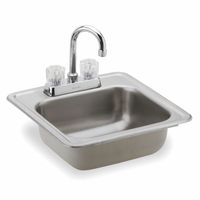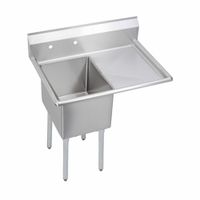Call +(254) 703 030 000 / 751 483 999 / 721 704 777
- Home
- Plumbing
- Sinks Wash Fountains Repair Parts
- Kitchen Bar Sinks
Frequently Asked Questions
What are the different types of commercial kitchen sinks?
Commercial kitchen sinks come in various types, each designed to meet specific needs and comply with health regulations. Here are the main types:
1. **Compartment Sinks**: These are multi-basin sinks, typically with one to four compartments, used for washing, rinsing, and sanitizing dishes. They are essential for manual dishwashing processes.
2. **Bar Sinks**: Smaller sinks designed for bars or areas with limited space. They are used for washing glassware and small utensils.
3. **Prep Sinks**: These are smaller sinks used for food preparation tasks, such as washing vegetables or thawing meat. They are often located in the prep area of the kitchen.
4. **Hand Sinks**: Required by health codes, these sinks are designated for handwashing only. They are strategically placed to ensure easy access for staff to maintain hygiene.
5. **Mop Sinks**: These are floor-mounted sinks used for filling and emptying mop buckets. They help in maintaining cleanliness and are usually located in janitorial areas.
6. **Utility Sinks**: Versatile sinks used for various cleaning tasks, including washing large pots and pans. They are often deeper and more robust to handle heavy-duty cleaning.
7. **Drop-In Sinks**: Installed into a countertop, these sinks have a rim that sits on top of the counter. They are easy to install and replace.
8. **Undermount Sinks**: These are installed beneath the countertop, providing a seamless look and making it easier to clean the counter.
9. **Corner Sinks**: Designed to fit into corners, these sinks maximize space in smaller kitchens.
Each type of sink serves a specific function, ensuring efficiency and compliance with health standards in a commercial kitchen setting.
How do I choose the right size sink for my commercial kitchen?
1. **Assess Kitchen Needs**: Determine the volume and type of dishes, utensils, and equipment that need washing. Consider peak times and the flow of kitchen operations.
2. **Compliance with Regulations**: Check local health and safety regulations for minimum sink size and compartment requirements. Ensure the sink meets these standards.
3. **Number of Compartments**: Decide on the number of compartments needed. A three-compartment sink is common for washing, rinsing, and sanitizing. Additional compartments may be necessary for pre-soaking or defrosting.
4. **Size and Capacity**: Choose a sink that can accommodate the largest items you need to wash, such as pots, pans, and trays. Ensure it fits within the available kitchen space without disrupting workflow.
5. **Material and Durability**: Opt for durable materials like stainless steel, which is resistant to corrosion and easy to clean. Consider the gauge of the steel; lower numbers indicate thicker, more durable material.
6. **Faucet and Drainboard Options**: Consider the type of faucet needed (e.g., pre-rinse, swivel) and whether integrated drainboards are necessary for drying or additional workspace.
7. **Ergonomics and Accessibility**: Ensure the sink height is comfortable for staff to use and accessible for all employees, including those with disabilities.
8. **Budget Considerations**: Balance quality and cost. Investing in a durable, efficient sink can save money in the long run by reducing maintenance and replacement costs.
9. **Consult with Professionals**: Seek advice from kitchen designers or equipment suppliers who can provide insights based on your specific kitchen layout and needs.
What materials are best for commercial sinks?
The best materials for commercial sinks are stainless steel, cast iron, and composite materials, each offering distinct advantages suited to different needs.
1. **Stainless Steel**: This is the most popular choice for commercial sinks due to its durability, resistance to corrosion, and ease of maintenance. Stainless steel sinks are available in various gauges, with lower gauge numbers indicating thicker and more durable material. They are ideal for high-traffic areas like restaurants and hospitals because they can withstand heavy use and are easy to clean and sanitize. Additionally, stainless steel is resistant to heat and chemicals, making it suitable for environments where hygiene is crucial.
2. **Cast Iron**: Cast iron sinks are coated with a layer of enamel, providing a durable and aesthetically pleasing finish. They are known for their strength and longevity, making them suitable for commercial kitchens that require a robust sink. The enamel coating is resistant to scratches and stains, although it can chip if subjected to heavy impact. Cast iron sinks are heavier than stainless steel, requiring sturdy support, but they offer a classic look and excellent noise reduction.
3. **Composite Materials**: These sinks are made from a blend of materials such as quartz or granite mixed with resins. Composite sinks are highly durable, resistant to scratches, stains, and heat, and offer a variety of color options. They provide a modern aesthetic and are less noisy than stainless steel sinks. Composite sinks are ideal for commercial settings that prioritize design and functionality, such as upscale restaurants or boutique hotels.
Each material has its own set of benefits, and the choice depends on the specific requirements of the commercial environment, including durability, maintenance, aesthetics, and budget.
How do I maintain and clean a commercial stainless steel sink?
To maintain and clean a commercial stainless steel sink, follow these steps:
1. **Daily Cleaning**: Rinse the sink with warm water to remove food particles and debris. Use a mild dish soap and a soft sponge or cloth to scrub the surface. Rinse thoroughly and dry with a clean towel to prevent water spots.
2. **Weekly Deep Cleaning**: Create a paste using baking soda and water. Apply it to the sink and scrub gently with a non-abrasive sponge. Rinse well and dry. For stubborn stains, use a mixture of vinegar and water, spray it on the surface, let it sit for a few minutes, then rinse and dry.
3. **Removing Hard Water Spots**: Use a mixture of equal parts vinegar and water. Apply it to the spots, let it sit for a few minutes, then scrub with a soft cloth. Rinse and dry thoroughly.
4. **Polishing**: To restore shine, apply a small amount of olive oil or a stainless steel cleaner to a soft cloth and buff the sink in the direction of the grain. This also helps in protecting the surface from future stains.
5. **Avoid Harsh Chemicals**: Do not use bleach, ammonia, or abrasive cleaners as they can damage the finish. Also, avoid steel wool or metal brushes that can scratch the surface.
6. **Preventing Rust and Corrosion**: Ensure the sink is always dry when not in use. Avoid leaving metal pots or utensils in the sink for extended periods.
7. **Regular Maintenance**: Inspect the sink regularly for any signs of damage or wear. Address issues promptly to maintain the sink's appearance and functionality.
What are the benefits of undermount vs. drop-in sinks?
Undermount sinks offer a sleek, modern look as they are installed beneath the countertop, creating a seamless appearance. This design makes cleaning easier since there are no edges or crevices where debris can accumulate. They maximize counter space, providing a larger work area, and are often preferred for their aesthetic appeal, especially in high-end kitchens and bathrooms. However, they typically require professional installation and are best suited for solid surface countertops like granite or quartz.
Drop-in sinks, also known as top-mount sinks, are easier and less expensive to install, as they simply fit into a cutout in the countertop. They are versatile and can be used with a variety of countertop materials, including laminate. Drop-in sinks are generally more affordable and can be replaced or upgraded with relative ease. The rim of the sink provides additional support, making them a practical choice for heavy-duty use. However, the raised edge can make cleaning the countertop more challenging, as dirt and grime can accumulate around the lip.
In summary, undermount sinks offer a streamlined look and easier cleaning but require professional installation and are more costly. Drop-in sinks are budget-friendly, easier to install, and versatile but may require more maintenance around the edges. The choice between the two depends on budget, countertop material, and personal preference for style and functionality.
How do I install a commercial sink?
1. **Select Location**: Choose a suitable location with access to plumbing and drainage.
2. **Gather Tools and Materials**: You’ll need a wrench, screwdriver, plumber’s tape, silicone sealant, level, and the sink components.
3. **Prepare Plumbing**: Ensure water supply lines and drainage pipes are in place. Shut off the water supply.
4. **Assemble Sink Components**: Attach legs or mounting brackets to the sink. If it’s a wall-mounted sink, ensure the wall can support the weight.
5. **Position the Sink**: Place the sink in the desired location. Use a level to ensure it’s even.
6. **Secure the Sink**: For wall-mounted sinks, drill holes and use anchors to secure the brackets. For floor-mounted sinks, adjust the legs and secure them.
7. **Connect Water Supply**: Attach the water supply lines to the sink’s faucet. Use plumber’s tape on threads to prevent leaks.
8. **Install Drain**: Attach the drain assembly to the sink. Ensure it’s tightly sealed with plumber’s putty or silicone sealant.
9. **Connect to Drainage**: Attach the sink’s drain to the existing plumbing. Ensure all connections are tight to prevent leaks.
10. **Test for Leaks**: Turn on the water supply and check for leaks. Tighten connections if necessary.
11. **Seal Edges**: Apply silicone sealant around the edges of the sink to prevent water seepage.
12. **Final Adjustments**: Ensure the sink is stable and all connections are secure.
13. **Clean Up**: Remove any debris and clean the sink area.
14. **Inspect**: Double-check all connections and the stability of the sink.
What are the common features to look for in a commercial bar sink?
When selecting a commercial bar sink, consider the following features:
1. **Material**: Stainless steel is preferred for its durability, resistance to corrosion, and ease of cleaning.
2. **Size and Configuration**: Choose a size that fits your space and meets your needs. Common configurations include single, double, or triple compartments.
3. **Depth**: Deeper sinks accommodate larger volumes of glassware and reduce splashing.
4. **Drainboards**: Integrated drainboards provide space for drying glassware and utensils.
5. **Faucet Compatibility**: Ensure the sink is compatible with commercial-grade faucets, often requiring pre-drilled holes.
6. **Backsplash**: A built-in backsplash prevents water from damaging walls and provides a cleaner look.
7. **Sound Dampening**: Look for sinks with sound-deadening pads or coatings to minimize noise.
8. **Ease of Installation**: Consider whether the sink is drop-in, undermount, or wall-mounted, based on your installation preferences.
9. **NSF Certification**: Ensures the sink meets health and safety standards for food service.
10. **Accessories**: Consider additional features like cutting boards, colanders, or glass racks that enhance functionality.
11. **Legs and Bracing**: Adjustable legs and cross-bracing provide stability and allow for height customization.
12. **Waste Drainage**: Efficient drainage systems, such as basket strainers, prevent clogs and facilitate easy cleaning.
13. **Finish**: A polished or brushed finish can affect the sink's appearance and ease of maintenance.
14. **Price and Warranty**: Balance cost with quality and check for warranties that offer protection against defects.
These features ensure the sink is practical, durable, and compliant with industry standards, enhancing the efficiency and hygiene of your bar operations.

